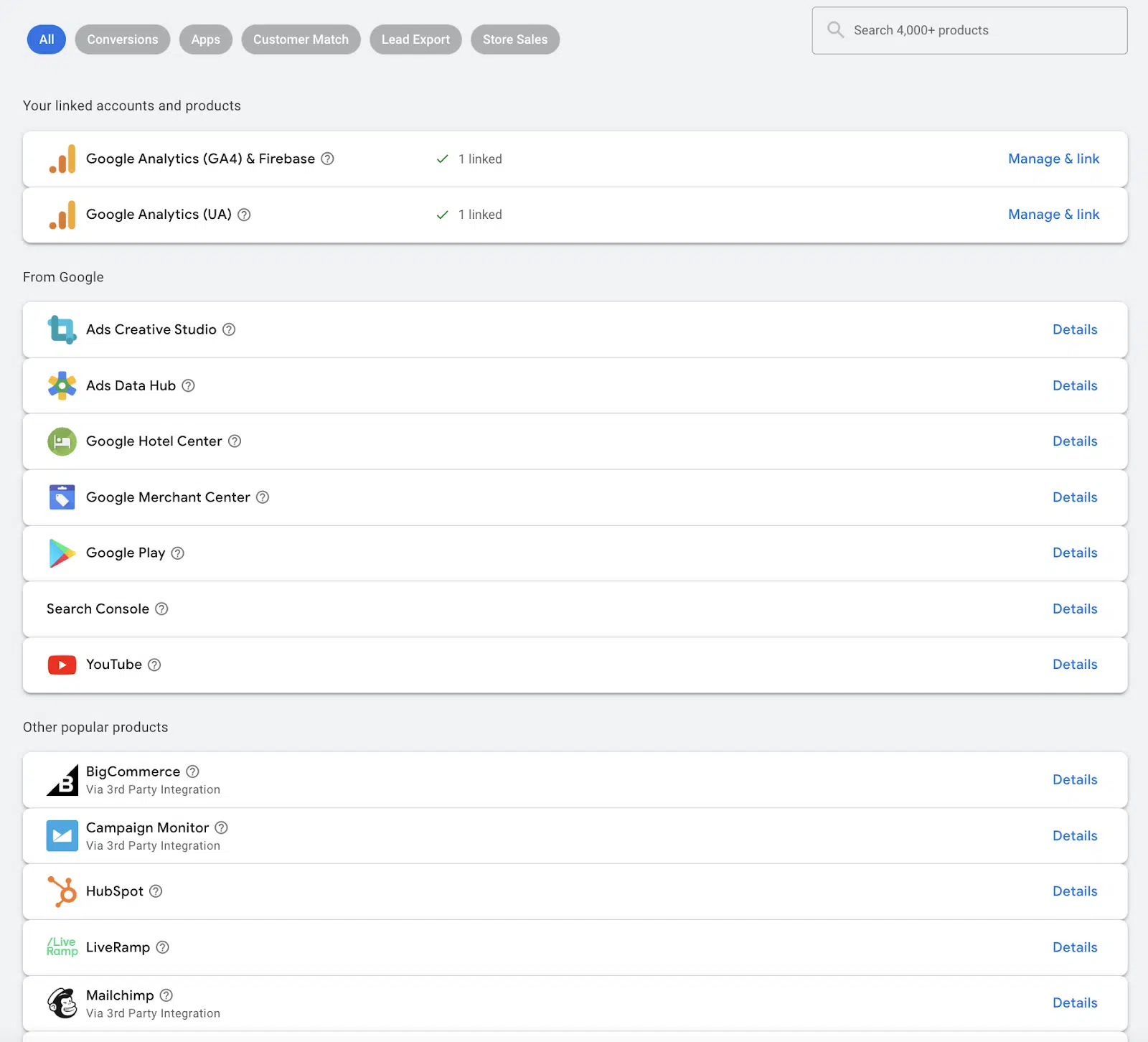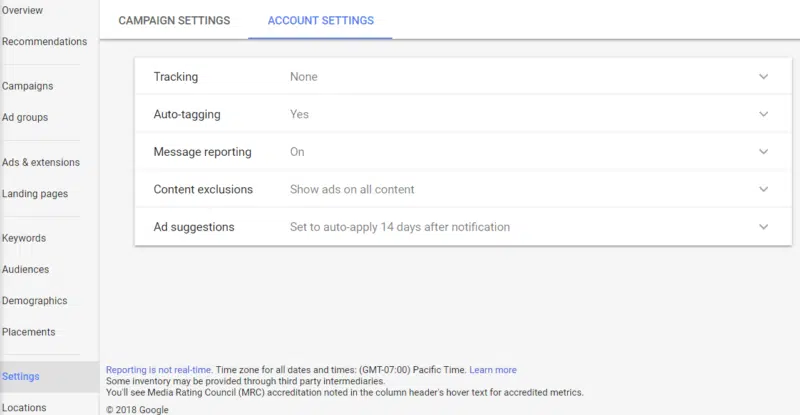How to set up your PPC account
Payment information, key contact information, and permission access are housed at the account level in Google Ads. Each business or client should have a separate account, and there are times when one business will have multiple accounts.
For text ads, Google enables advertisers to set up Responsive Search Ads. You can set up as many as you like, but only one will show at a time.
Shopping ads are an exception to this rule, where multiple related products from the same seller may appear in the results.
Don’t try to game the system by setting up multiple accounts in order to show more than one ad in the results. It’s a policy violation that won’t end well.

The account setup sections can be located from the Tool icon in the upper right menu in Google Ads.
In Billing & Payments, you’ll set up your credit card and contact information. There is an invoicing option, but you’ll need to contact Google to set this up.
Business data is an area that you’ll come back to after setting up your account. This is where ad extension feeds, ad customizer data, dynamic display ad feeds and page feeds are housed.
Linked accounts
Before you launch your first PPC campaigns, you’ll want to link your accounts from other Google services in order to transfer data back and forth between them.
If you use Google Analytics, this is particularly important. You can import conversion goals and audiences from Analytics into Google Ads.
From Analytics, you’ll be able to analyze your Google Ads campaign performance, compare it to other channels and most importantly, understand how people who click on your ads behave when they get to your site.
Linking Google Search Console will enable you to import organic search results, compare your organic and paid coverage and see how your ads and organic listings perform together and alone.
Google shares signed-in user data across its services. Linking your YouTube channel to Google Ads will allow you to run video campaigns on YouTube, build retargeting lists of people who watch your videos and measure engagement on your video ads.
If you use Salesforce, you can link those accounts to import sales lead and funnel data into Google Ads to optimize your campaigns based on outcomes that occur after a lead comes in from an ad click.
Overall, there are more than 20 different linking options available.

Account settings
After you finish the account setup steps, click on Settings toward the bottom of the left navigation, and then click the Account Settings tab as shown below.

Tracking Template
If you’re using a third-party click-tracking platform, this is where you can add tracking parameters that will apply to your entire account. (There are also options to add tracking templates at the campaign, ad group and keyword levels.)
This is also where you can add account-level ValueTrack parameters to track more about the clicks on your ads in either Google Analytics or a third-party analytics platform.
Auto-tagging
If you’re using Google Analytics, be sure to link your accounts as discussed in the previous section, and then enable Auto-tagging from this section.
Auto-tagging will automatically append the UTM codes that Google Analytics relies on to ingest and categorize campaign information.
If you don’t enable auto-tagging and don’t manually add UTM tracking to your destination URLs, all of your Google Ads campaign data will show up as Google/organic traffic in Google Analytics, and you won’t be able to measure your PPC campaigns in Analytics.
Negative keywords
Account-level negative keywords prevent your ads from showing to people who search for or browse content related to those words.
Define up to 1,000 negative keywords to apply to all eligible Search, Shopping, and Performance Max campaigns.
Manager accounts for managing multiple PPC accounts
If you will be managing multiple Google Ads accounts, a Manager Account (formerly called a Master Client Center or MCC) is incredibly helpful.
Agencies can house their individual client accounts under an umbrella Master Account. A company with multiple business units or distinct brands and websites can house them in a Manager Account.
The other, rarer example is when a company’s account becomes so large it hits the account limits, and another account has to be created and linked. (If this happens, you’ll need to work with Google to accommodate you.)
In a Manager Account, you can get a dashboard view of all your clients or in-house accounts in one place.
You can link existing accounts to a Manager Account or create new accounts within a Manager Account.
- Microsoft Advertising note: Microsoft Advertising also has a version of a master account designed primarily for agencies. If you’re at an agency and need to set up a new account for a client, set it up outside of the master account and then go through the linking process. If you create a new account from within an agency account, it cannot be unlinked later.
Other benefits of a Manager Account in Google Ads include the ability to set up negative keyword lists that can be applied to multiple accounts and to create audiences that can be shared across accounts.

If you think list-sharing across accounts sounds like a potential privacy issue, you’re right. From this help page:
Important: When sharing data segments and combined segments across accounts, remember that you may be sharing confidential or proprietary data. You should only share data segments with other accounts if you have obtained permission from accounts that own them and such sharing doesn’t violate any agreements you have with those accounts. For additional requirements and details about data segments in Search ads, check the policy for data use in personalized ads.
It’s not just the accounts themselves you need to get permission from. In light of the EU’s General Data Protection Regulation (GDPR) and California’s privacy law CCPA, you may also need to verify that each business has acquired the proper user consent to target that list of users.
Chapter 6 of our guide will teach you how to structure PPC ad campaigns.
Read more of Search Engine Land’s Complete Guide to PPC (Pay-Per-Click) Advertising:
- What is PPC – Pay-Per-Click marketing?
- Chapter 1: Where PPC ads appear
- Chapter 2: How the PPC ad auction works
- Chapter 3: How to build an effective PPC strategy
- Chapter 4: How to track and measure PPC campaigns
- Chapter 5: How to set up up your PPC account
- Chapter 6: How to structure PPC campaigns
- Chapter 7: PPC keyword research and match types: what’s important
- Chapter 8: Setting up a paid search campaign
- Chapter 9: Beyond keyword targeting in Search: location, device, audience and demographic
- Chapter 10: Bidding and bid adjustments in paid search campaigns
New on Search Engine Land